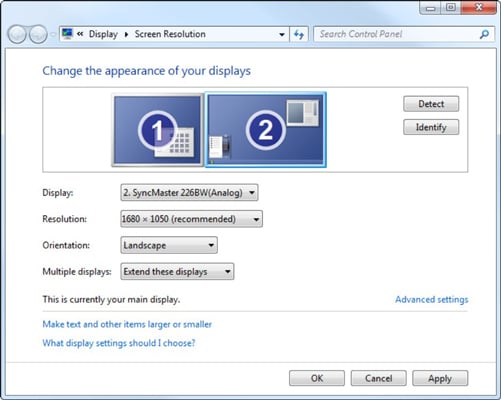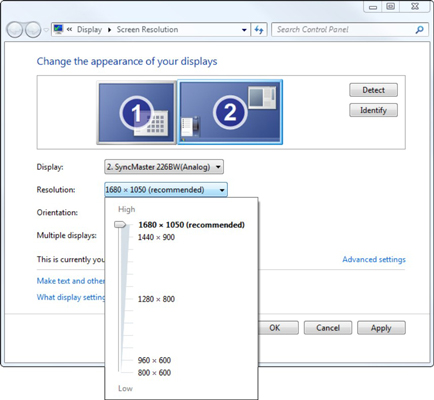Windows 7 makes working with multiple monitors easier than ever. Although previous versions of Windows will allow you to use multiple monitors, Windows 7 allows you to really control the display by changing the resolution, orientation, and appearance of items in each monitor.
Once you've plugged in all the monitors you want to use and hooked them up to your computer,
Right-click in any blank place on the Windows 7 desktop and choose Screen Resolution.

You see the Display Settings dialog box, where you can set up multiple monitors.
Click the 1 box to set up your first monitor and 2 to set up the second.
You can set up as many as four monitors.
If you can’t figure out which monitor is which, click the Identify Monitors button. Windows 7 puts a big 1 on the actual Monitor 1 and a big 2 on Monitor 2.
You can also choose where to show the primary desktop.
You have several options for each monitor.
Setting Name Shown on Monitor 1 Shown on Monitor 2 Duplicate These Displays The usual Windows desktop Exactly the same as Monitor 1 Extend These Displays The usual Windows desktop A blank area where you can drag and drop anything you like; behaves as though it’s to the right of Monitor 1 Show Desktop Only on 1 The usual Windows desktop Nothing Show Desktop Only on 2 Nothing The usual Windows desktop To change the orientation of one of the monitors, click the desired monitor and select the desired orientation from the drop-down box.
Windows 7 allows you to have one monitor in typical landscape view and the other rotated to portrait view, which is particularly handy for document viewing.
To change the resolution on either display, click the desired monitor and then adjust the resolution using the vertical slider.

If Windows 7 properly identified your monitor and you have a sufficiently powerful video card, this dialog box should already show the monitor’s native resolution.
Click the Apply button.
Windows 7 changes the display’s resolution and opens a dialog box that asks whether you want to keep the new settings.
Click the Keep Changes button to keep the new settings or click Revert to return to the old ones.
If the display becomes unreadable, press Esc to return to the old settings. (Or, if you wait 15 seconds, Windows 7 returns to the old settings automatically.) If you can’t read the screen, you chose a resolution that your monitor can’t display.
When you’re done, click the OK button to close the Display Settings dialog box.
Windows 7 contains many handy keyboard shortcuts, and if you use multiple monitors, there are a couple of shortcuts just for you.
If you want to use the Aero Snap feature on the side of the window next to the extra monitor, you'll find that your window will just fall off the desktop and on to the next monitor. To dock the window to either side of a given monitor, just press the Windows key + Left/Right arrows.
To quickly jump a window from one monitor to the next, press Windows key+Shift+Left/Right arrow. The window will move to the adjacent monitor.

